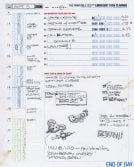The first thing that came apparent was the need to define my time. I had to do this in a way that was both flexible and clear. The only productivity/time management tools I kept are Google Calendar, my Miquelrius spiral grid notebook, and Thunderbird for email. So the first thing was to establish a process and pick some tools to track it. After some consideration, I chose John Richardson’s The Focused 50 for its clearly defined boundaries. Since a bulk of my workload consists of several smaller tasks, it fit my ideal time-boxing methodology well. To track the time and schedule out my day, I chose David Seah’s Emergent Task Planner. The form is easy to use, very efficient, and allows me to capture everything for each day in one place. These 2 tools are paired with my notebook, where I capture all my actions and project info, then process out to the daily task planner. I needed simplicity with clarity. That is my ultimate goal for this experiment. To establish a process that works for me and my somewhat odd daily schedule, and allows me to plan things accordingly. So for my base process and tools, this is what I will be using:
Google Calendar for scheduled appointments Miquelrius grid notebook for capturing, and notes The Focused 50 for daily time-boxing process Emergent Task Planner for outlining each day and tracking
The idea is to keep the process as agile as possible, while being able to clearly define timelines and actions. The Verdict: Even after only about a week of using it, I’ve found that this base process works well for me. The goal of this experiment is to allow me to have ample time to get my new venture ready to launch, while keeping up with my other projects and commitments. I’m not sure how well this lean of a process would work for someone who wasn’t able to set their own schedule and agenda. For those who are self-employed or do clearly defined project work, it fits very well. At this point I will continue to use this as my base process, and will discuss it further in the 30-day progress podcast. Alternatives: In addition to the Emergent Task Planner, David Seah has several other tools in his Printable CEO Series that could fit. Also, there are several templates in the DIY Planner that can also be used in a similar way. Since Miquelrius notebooks are becoming increasingly difficult to find, I am also going to consider the Levenger Circa or other Rollabind notebooks with grid sheets (hat tip to Kenny for the recommendation). Next Up: Brainstorming and high level planning tools.
Other Entries in this Series
Trial By Fire Productivity – The Intro
Tony D. Clark is an entrepreneur, writer, and artist who spends a lot of time talking others into profiting from what they know, being creative, and doing what they love. His blog Success from the Nest provides inspiration, tips, and advice for the home-based entrepreneur and those aspiring to be one – all served up with humor and cartoons.
